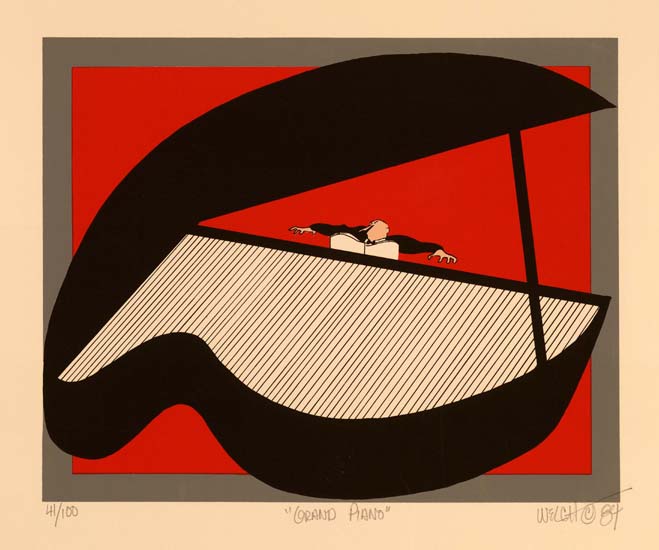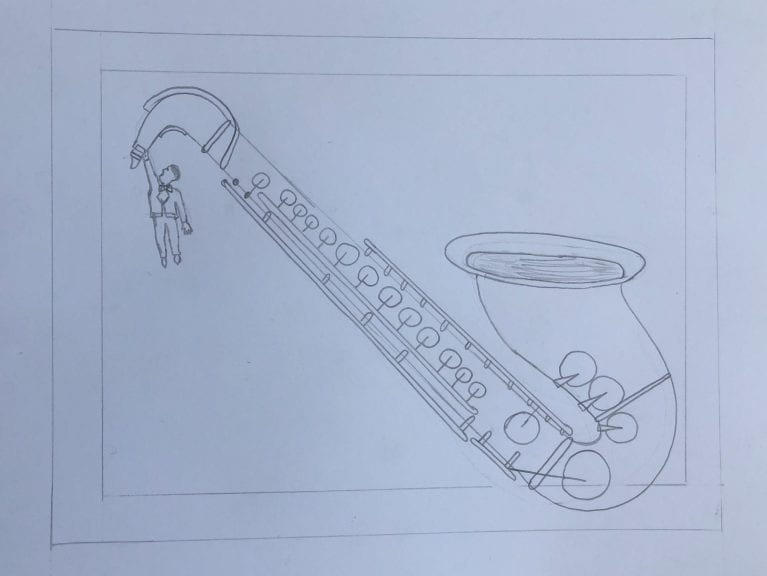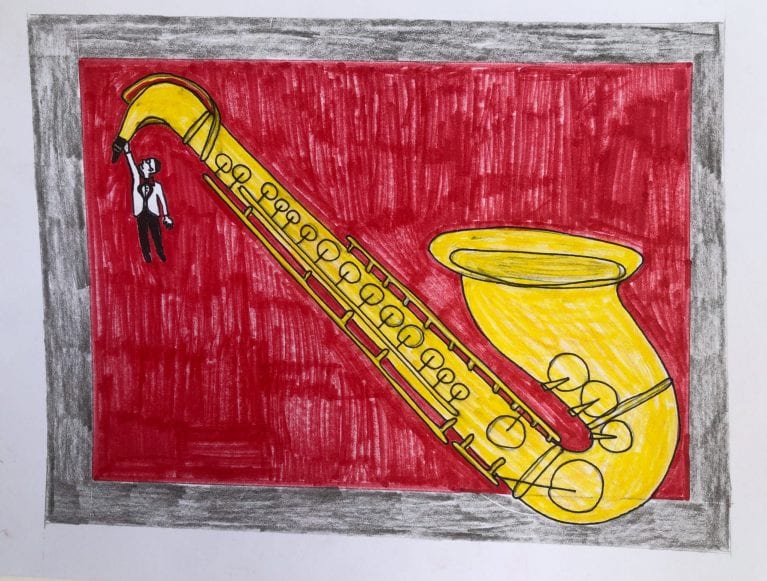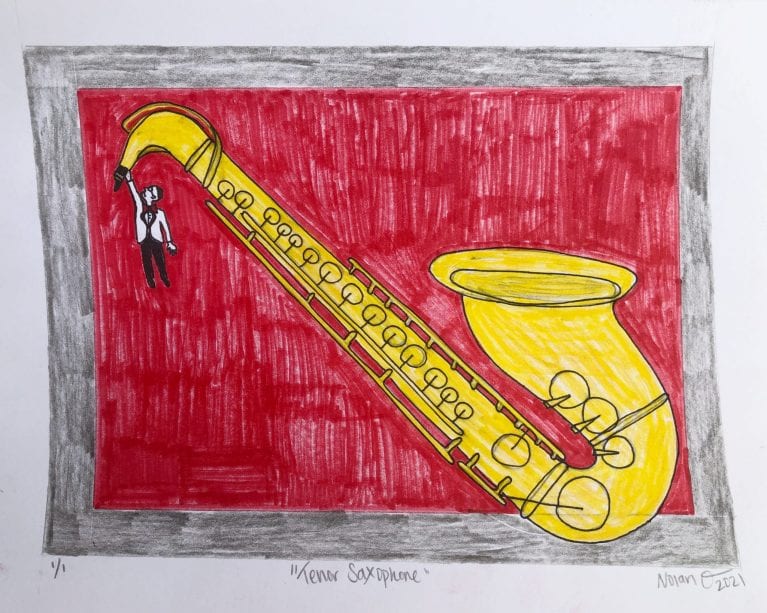Draw your favorite instrument inspired by Walter Wade Welch’s Grand Piano.
Download Activity
Walter Wade Welch, Grand Piano, 1984, Colored lithograph on paper, Gift of the Roger H. Ogden Collection.
Walter Wade Welch was born on June 21, 1951 in Montgomery, Alabama. Welch moved to New Orleans in 1983 to manage the 927 Art Gallery located in the French Quarter. Welch produced highly detailed, whimsical ink pen drawings. His work was exhibited in Baton Rouge and New Orleans as well as published in magazines, newspapers and books. Welch passed away at the age of 58 but his legacy lives on through his art.
Supplies
Paper, Pencil, Markers, Ruler
Instructions
Step 1: Look at Walter Wade Welch’s artwork, Grand Piano. What do you notice about his artwork? Welch uses flat planes of color and simplifies the piano into its basic components. The man is tiny in comparison to the large piano, which gives Welch’s work a whimsical and playful feeling.
Step 2: Do you play a musical instrument? What is it? If you don’t play an instrument, what is your favorite instrument? Use Google with a parent or guardian’s permission, and search “Instruments” to find detailed images to use as a reference. If you can’t use the Internet, look in books for examples or use your imagination!
Step 3: Use a pencil and ruler to draw a frame on your paper. Think about the composition of your drawing. Where will you position your instrument in relation to the frame? Will it be within the frame, overlapping the frame, like Welch has done or bursting out of the frame?
Step 4: Draw your favorite instrument! In Welch’s Grand Piano, he simplifies the piano. Look at the basic components of your instrument and see if you can simplify it. Sketch the basic shapes of the instrument. Add details to your instrument. Does it have keys, strings or another method of playing it?
Step 5: You can add a little figure in your drawing and position them around the instrument! Will the figure be playing the instrument?
Step 6: Add color to your drawing! Welch uses flat planes of color to render the background of his work. Choose any color you want for the background! Next, color the instrument and the figure.
Step 7: Title, sign and date your drawing! Welch writes the title of his work in the middle of the bottom of his paper, but you can sign your artwork anywhere!
Vocabulary
Composition – the arrangement of elements within an artwork
SEE WALTER WADE WELCH’S GRAND PIANO IN THE PERMANENT COLLECTION AT OGDEN MUSEUM.
CHECK OUT THE O BLOG FOR MORE RESOURCES!
QUESTIONS? EMAIL EDUCATION@OGDENMUEUSM.ORG



Actividad artística O-riginal: Dibujo inspirado por Walter Wade Welch
Dibuja tu instrumento favorito, inspirándote en Gran Piano de Walter Wade Welch.
Descargar Actividad
Walter Wade Welch, Grand Piano, 1984, Colored lithograph on paper, Gift of the Roger H. Ogden Collection. | Walter Wade Welch, Gran Piano, 1984, litografía coloreada sobre papel, obsequio de la colección de Roger H. Ogden
Walter Wade Welch nació el 21 de junio de 1951 en Montgomery, Alabama. Welch se mudó a Nueva Orleans en 1983 para administrar la Galería de Arte 927 ubicada en el barrio francés. Welch realizó dibujos extravagantes y muy detallados con pluma. Su trabajo se exhibió en Baton Rouge y Nueva Orleans y fue publicado en revistas, periódicos y libros. Welch falleció a la edad de 58 años, pero su legado sigue vivo a través de su arte.
Materiales
Papel, lápiz, marcadores, regla.
Instrucciones
Paso 1: Mira la obra de arte de Walter Wade Welch, Gran Piano. ¿Qué notas sobre su obra de arte? Welch utiliza planos planos de color y simplifica el piano en sus componentes básicos. El hombre es pequeño en comparación con el piano grande, lo que le da a la obra de Welch una sensación extravagante y divertida.
Paso 2: ¿Tocas algún instrumento musical? ¿Cuál? Si no tocas ningún instrumento, ¿cuál es tu instrumento favorito? Utiliza Google con el permiso de un padre o tutor y busca “instrumentos” para buscar imágenes detalladas y utilizarlas como referencia. Si no puedes usar Internet, busca ejemplos en libros o usa tu imaginación.
Paso 3: Utiliza un lápiz y una regla para dibujar un marco en tu papel. Piensa en la composición de tu dibujo. ¿Dónde colocarás tu instrumento en relación con el marco? ¿Estará dentro del marco, sobreponiéndose al marco, como lo ha hecho Welch o saliendo del marco?
Paso 4: ¡Dibuja tu instrumento favorito! En su obra Gran Piano, Welch simplifica el piano. Observa los componentes básicos de tu instrumento y fijate si puedes simplificarlo. Dibuja las formas básicas del instrumento. Agrega detalles a tu instrumento. ¿Tiene teclas, cuerdas u otro método para tocarlo?
Paso 5: ¡Puedes agregar una pequeña figura en tu dibujo y colocarla alrededor del instrumento! ¿La figura tocará el instrumento?
Paso 6: Welch utiliza planos planos de color para representar el fondo de su trabajo. ¡Elige el color que desees para el fondo! A continuación, colorea el instrumento y la figura.
Paso 7: ¡Titula, firma y fecha tu dibujo! Welch escribe el título de su trabajo en el medio de la parte inferior de su papel, ¡pero puedes firmar tu obra de arte en cualquier lugar!
Vocabulario
Composición: es la disposición de elementos en una obra de arte.
VÉ MÁS DE GRAN PIANO DE WALTER WADE WELCH EN LA COLECCIÓN PERMANENTE DEL MUSEO OGDEN.
¡VISITA THE O BLOG PARA MÁS RECURSOS!
¿PREGUNTAS? ENVÍA UN EMAIL A EDUCATION@OGDENMUEUSM.ORG
Translation by Agostina Coll



